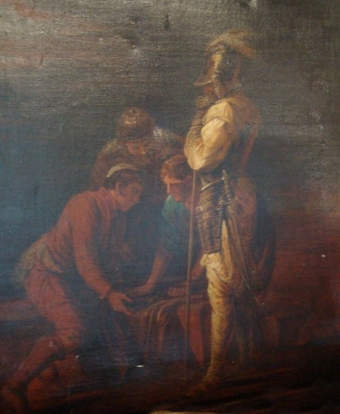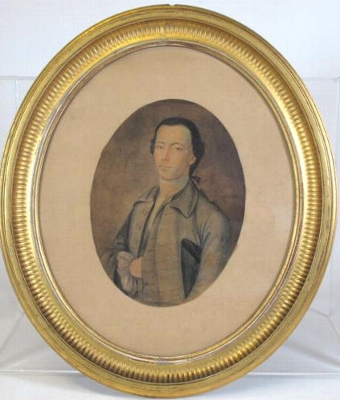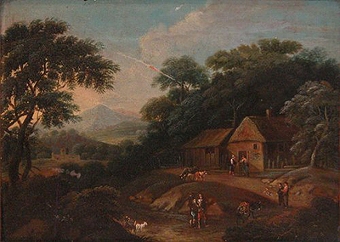St Margaret''s Church is an Anglican church in Rottingdean, in the English city of Brighton and Hove. It is the parish church of the previously separate village of Rottingdean, which became part of the former Borough of Brighton in 1928. Parts of the structure date from the 13th century, and it is a Grade II* listed building.
The church is in the northeastern corner of the Green, the ancient heart of the village. A place of worship has stood in the position since the Saxon period, although there is disagreement over whether any part of the current structure is of Saxon origin. The Normans started building a cruciform church in the early 12th century, but its tower (located on the site of the Saxon building''s chancel) collapsed during construction, destroying the new chancel and the transept, although the nave survived. By the early 13th century the chancel had been rebuilt and the nave extended by four bays. These were added to the south aisle, but this fell out of use after 1377 when the church and surrounding buildings were sacked by French invaders who had landed on the coast nearby. Damage to the west wall necessitated rebuilding at the same time, and the south aisle was blocked up.The church remained structurally unaltered until a major restoration in 1856 by Sir George Gilbert Scott. A new three-bay south aisle was built; Scott removed an ancient window from the original aisle and built it into one of the new walls. The chancel wall was also partly rebuilt at this time. Earlier in the 19th century, box pews and a gallery were added; Scott removed the gallery during his restoration. Additions in the 20th century comprised a porch at the west entrance, erected in 1908, and vestries in one corner of the nave, added in the 1970s in a style appropriate to the mediaeval architectural style of the church. A new gallery, at the west end of the nave and accommodating the organ, was also built in 1908; the original gallery had been on the south side. The bowl of the original Norman font was discovered in the vicarage garden; a replica was made in 1910, and the original bowl was displayed in the church.
Sir Edward Burne-Jones, Pre-Raphaelite artist and designer, is buried in the nave. His wife Georgiana, one of the MacDonald sisters, and their granddaughter, novelist Angela Thirkell, are also buried there.The ancient churchyard, extended in 1883, 1905 (with land donated by William Nevill, 1st Marquess of Abergavenny) and 1920, includes the graves of Scottish novelist William Black and music hall entertainer G. H. Elliott.
Lucy Ridsdale, daughter of Edward Ridsdale of The Dene, a house on the village green, married Stanley Baldwin in the church in 1892. He later served as Prime Minister of the United Kingdom on three occasions. The Baldwins donated a chair to the church in 1942; this stands in the chancel. Sir Edward Burne-Jones, who designed many of the stained glass windows in the church, lived at a house on the village green for 18 years until his death in 1898. He was the uncle of author and poet Rudyard Kipling, who moved to a nearby house (The Elms) in 1897. Kipling wrote many of the Just So Stories during his time there.In the early 20th century, a proposal was received from the developers of the Forest Lawn Memorial Park, a private cemetery in Glendale, California. They wanted to buy the church, dismantle it stone by stone, ship it to the United States and rebuild it in the park. A price was offered, but the sale was refused, so in the 1940s a series of drawings were made, and an exact replica was built instead.This was called the Church of the Recessional to commemorate Kipling''s poem "Recessional".Rottingdean is a coastal village next to the town of Brighton and technically within the city of Brighton and Hove, in East Sussex, on the south coast of England. It borders the villages of Saltdean, Ovingdean and Woodingdean, and has a historic centre, often the subject of picture postcards. The name is Old English for ''valley of the people associated with Rota (a male personal name)''. Rottingdean is in a dry valley whose sides in the upper reaches are quite steep, and this valley comes right down to the English Channel coast. The name was contrasted unflatteringly with Goodwood (another place in Sussex) in a national 1970s advertising campaign for wood preserver. Rottingdean has approximately 2,500 inhabitants. For most of its history it was a farming community, but from the late 18th century it attracted leisured visitors wanting a genteel alternative to raffish Brighton, among them some names famous in English cultural life. Some, in the late 19th century, notably the painter Sir Edward Burne-Jones and his nephew Rudyard Kipling, made it their home. Kipling''s old house adjacent to Kipling Gardens is still standing, and the former house of the painter Sir William Nicholson is currently open to the public as a library and museum. When farming collapsed in the 1920s, much of the farmland became available for building, and Rottingdean increased significantly in population, especially in the area known as Saltdean. A large number of smallholdings appeared in the detached part of the parish called Woodingdean.
In the summer of 1377 the French pirate raid on Rottingdean occurred. The raiders probably intended to pillage the nearby Lewes priory. The raiders were detected as they landed, and a portion of the village''s inhabitants retreated into the church''s Saxon-built tower. The pirates were unable to take the tower and set it on fire; over a hundred people are thought to have died in the blaze. The next day the pirates were met by a force led by the Lewes Prior. During the action, two knights, Sir John Fallisle, Thomas Chinie and the prior were captured. The pirates were, however, driven to depart, with the three men later being ransomed.Rottingdean is also notable for the black wooden windmill on the hill on its western side. Nicholson made a woodcut that was used as the logo of the publisher William Heinemann; this is often said to have been a depiction of Rottingdean mill, but a glance at both will show that this is untrue. The Rottingdean Preservation Society and its earlier incarnations have been responsible for maintaining the Windmill since 1923. It was successful in getting a Heritage Lottery Fund Grant of ?41,800 which together with funding from the society has ensured that the Windmill remains a remarkable Grade 1 listed attraction in the twenty first century. The hill is a local nature reserve. It was also well known for sport, having a cricket club founded in 1758 and having been a centre of fox hunting, especially in the second half of the 19th century. Its most historic other building is its probably 13th-century church of St Margaret, constructed in flint and having a short spire with a cap. An almost exact replica has been constructed at the Forest Lawn Memorial Park, Glendale, California. The Rottingdean church features stained glass by Edward Burne-Jones, whose ashes are buried in the churchyard. Other modestly well-known burials include those of the Victorian novelist William Black, Burne-Jones''s granddaughter the author Angela Thirkell, and the 1920s music-hall star G.H. Elliott, known professionally as "The Chocolate-Coloured Coon". Here is also the grave of the last "squire" of Rottingdean, Steyning Beard, who died in 1909; much of his land was ultimately sold off to pay his debts. Most of these well-known people were not local, and had settled in or retired to Rottingdean. The village also had home-grown talent of significance, notably the Copper Family who maintained a long tradition of English folk song, performing for the collector Kate Lee as early as 1892. Its best-known member was Bob Copper (1915-2004), also known as a writer. The Rottingdean Preservation Society recognised their importance in the village and erected a plaque in 2010 at 1 Challoners Cottages, partly funded from its own resources but complemented by a donation from the English Folk Dancing Society.
John Louis Petit was born at Ashton-under-Lyne, Lancashire, son of John Hayes Petit. He was educated at Eton, and contributed to the "Etonian". He was elected to a scholarship at Trinity College Cambridge in 1822, graduated BA in 1823 and MA in 1826, and on 21st June 1850 he was admitted "ad eundem" at Oxford. He took holy orders in 1824, but undertook no parochial work.
Petit showed a taste for sketching in early years. His favourite subject was old churches, and a great part of his life was spent in visiting and sketching them. In 1839 he made his first extensive tour of the continent. The results appeared in his "Remarks on Church Architectire" (1841, 2 vols which had illustratuions. It was followed in 1846 by "Remarks on Church Architectural Character" Royal folio format.In the same year Petit published a lecture which he had delivered on 24th Feb 1846 to the Oxford Society for promoting the study of Gothic Architecture, under the title "Remarks on the Principles of Gothic Architecture as applied to ordinary Parish Churches". It was succeeded by "Architectire of Tewksbury Abbey Church". Royal svo 1846. " Architectural notes in the neighbourhood of Cheltenham"and "Remarks on Wimborne Minster", 1847. "Remarks on Southwell Minster". With numerous good illustrations. 1848. "Architectural Notices relating to Churches in Gloucestershire and Susse". 1849. "Architectural Notices of the Curious Church of Gillingham.Norfolk". And an "Account of Sherborne Minster". 1850. In 1852 Petit published an account of Brinkburn Priory".
In 1854 appeared Petit''s principal work. "Architectural Studies in France", imperial SVO. It was beautifully illustrated with fine woodcuts and facsimiles of anastic drawings by the author and his companion, Professor Delamotte. It showed much learningand observation, and threw light upon the formation of Gothic in France, and on the differences between English and French Gothic. A new edition , revised by Edward Bell, FSA, with introduction, notes and index, appeared in 1890. The text remained unaltered but the illustrations were reduced in size, and a few added from Petit''s unused woodcuts. In 1864-65 he travelled in the East and executed some striking drawings. He died in Lichfield on 2 Dec 1868, from a cold caught while sketching and was buried in St Micheal''s Churchyard. Petit was the founder of the British Archealogical Institute at Cambridge in 1844. He was also FSA, an honoury member of the Institute of British Architects, and a governor of Christ''s hospital.
Antiques.co.uk Ref: 5Y72TK9V
- Materials:
- Pencil/watercolour














